Transform Your Enterprise: 7 Proven AI for Large Enterprises

Bryan Lin
Product Owner & COO

Share to AI
Ask AI to summarize and analyze this article. Click any AI platform below to open with a pre-filled prompt.
In my experience with AI for large enterprises, success comes down to more than the latest AI technology or tools. You’re balancing the push for digital transformation with the need to keep daily operations reliable. Every initiative is under the microscope. And the timeline is always shorter than you’d like.
Over the past year at Aloa, I’ve led enterprise AI solutions projects where the stakes were high and the outcomes had to be certain. We delivered AI consulting, process automation, and enterprise system integration that hit clear business objectives without adding operational risk. The common thread in each win? It’s aligning the AI strategy with business goals first, then choosing the right models and implementation path to serve those goals.
In this guide, I’ll share seven proven AI implementation strategies used by large enterprises, each one backed by actionable use cases, examples, and insights you can adapt to your own business processes. You’ll see exactly where the use of AI can deliver ROI, improve operational efficiency, and make better decisions at scale.
What Is Enterprise AI?
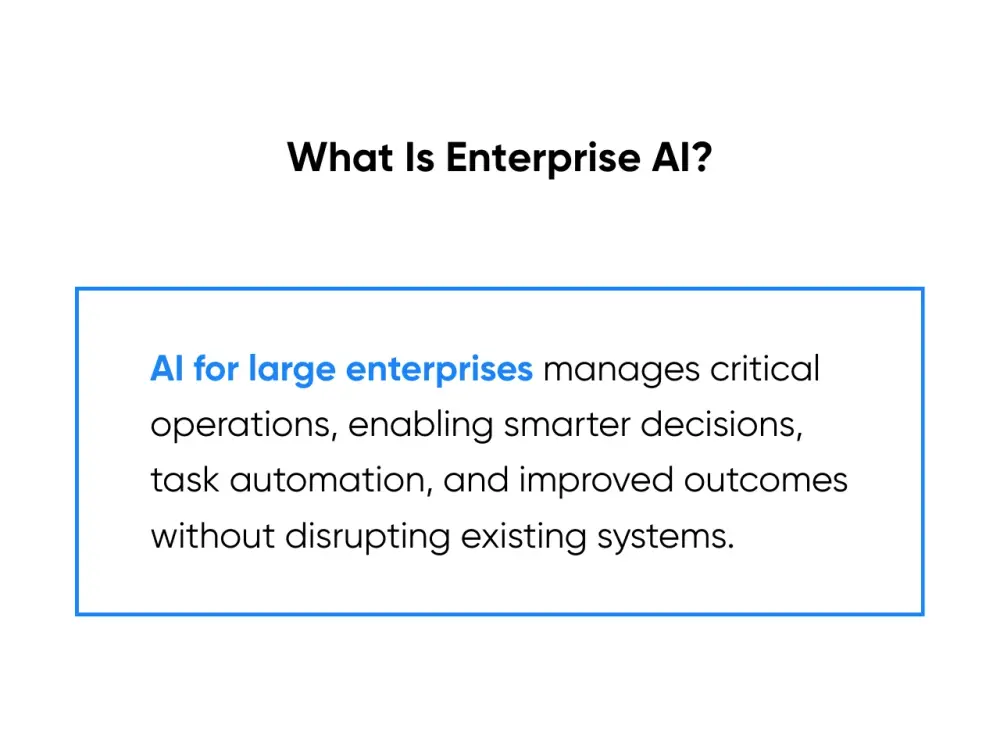
AI for large enterprises applies artificial intelligence to manage mission-critical business operations. It’s built to help a large organization make faster, smarter choices, automate routine tasks that consume the most resources, and improve results without disrupting enterprise systems already in place.
It’s very different from consumer AI. At this scale, enterprise AI needs to:
- Target a clear business goal: For example, adjust delivery routes and warehouse stock so transport costs drop by 12% and shipments arrive 18% sooner.
- Operate at massive scale: Run sales and inventory forecasts for hundreds of locations at once, factoring in seasonal trends and regional logistics.
- Protect sensitive data: Flag suspicious transactions instantly while encrypting every customer record to meet data governance and regulatory compliance standards.
- Integrate into existing workflows: Connect to your ERP or CRM so teams get AI-driven recommendations without learning new software.
These traits define where AI capabilities deliver the most impact, how to deploy them effectively, and what it takes to keep them producing value over time. To dive deeper, here are seven ways large enterprises are applying AI and how you can adapt them for your own operations:
1. AI-Powered Supply Chain Management
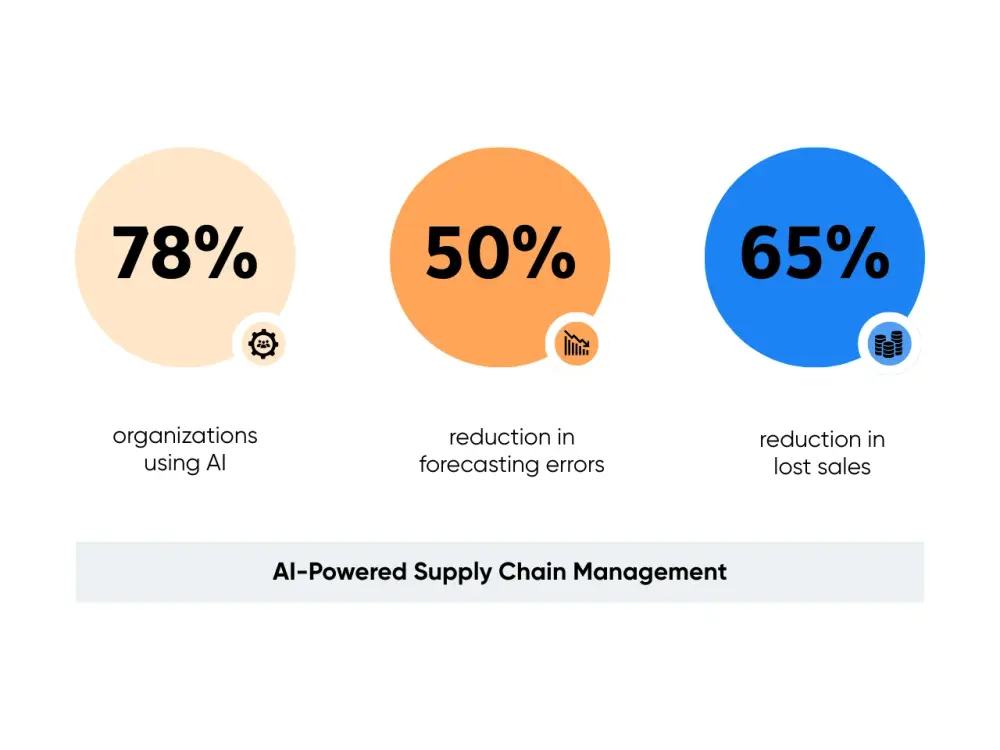
In supply chains, the smallest delay can ripple through the business. That often means missed delivery windows, higher freight costs, and frustrated customers. Even if you already track supplier lead times, inventory counts, shipment logs, and machine output, you still need to make sense of that data quickly enough to act.
According to a recent McKinsey Global Survey, 78% of organizations now use AI in at least one business function, and supply chain management ranks among the most valuable. In fact, research shows AI can reduce forecasting errors by up to 50% and cut lost sales by 65%, making it one of the fastest ways to protect both revenue and customer trust.
Predictive Analytics
I like to think of predictive analytics as a way to get pre-warnings. It’s constantly looking for the tiny shifts that signal trouble ahead. For example:
- You see supplier lead times stretch from 4 to 6 days over 20 shipments. Now you have the option to split orders with a backup before production slows.
- You see conveyor motor sensors show vibration and temperature creeping upward for three days. You decide to plan downtime rather than waiting for it to break down.
Predictive analytics is not just about avoiding surprises. Even with teams already monitoring supply chains, you may not be able to react fast enough when problems start to scale. A two-day supplier delay can leave thousands of shelves empty, and one machine breakdown can stall production across multiple plants.
Predictive analytics automates the early warnings, so issues get fixed while they’re still measured in hours instead of days. It’s an essential part of operations for large enterprises.
Demand Forecasting
Enterprises typically have teams that run demand forecasts, but instead of waiting for analysts to piece together sales data, marketing calendars, and weather reports, AI has the potential to process larger quantities of data faster than a human can. The difference may be able to help you:
- Move 10,000 units of inventory from slower East Coast warehouses when AI spots a 20% holiday sales spike brewing in the Southwest.
- Cut production on rain-dependent outdoor gear after models detect a wetter-than-average Midwest summer, which frees millions in budget and warehouse space for products that will actually sell.
At Aloa, we build AI models for demand forecasting that plug right into your ERP. That means you won’t have to rely on your team to chase numbers or push updates manually.
That’s how you stop reacting to last month’s problems, the way enterprise AI should work.
2. Advanced Customer Service with AI Chatbots
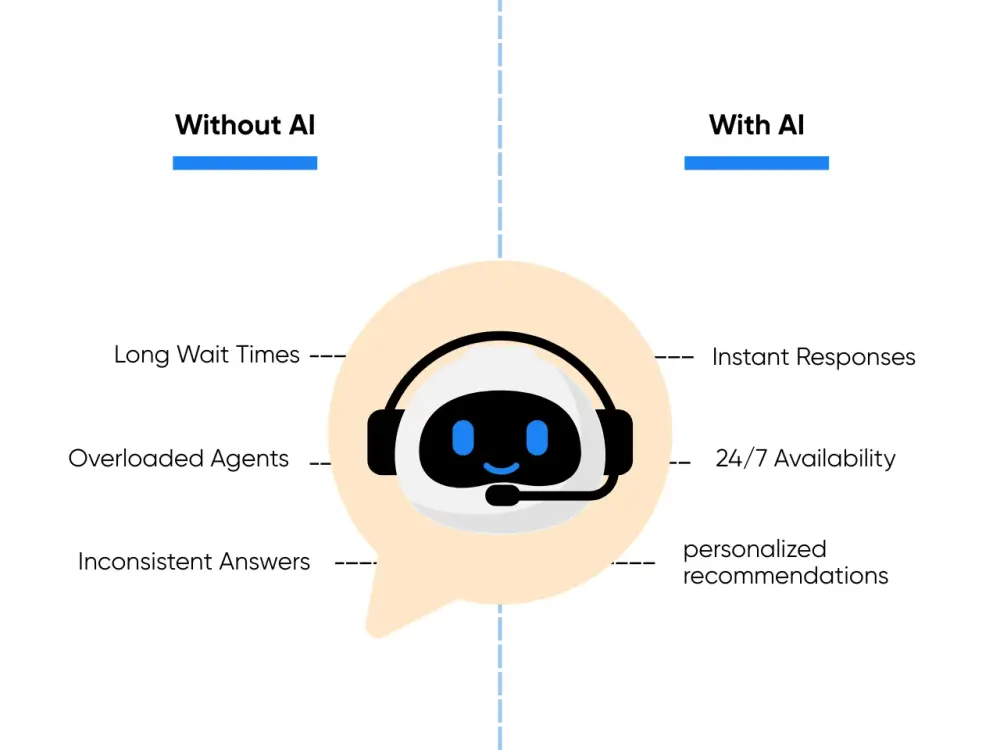
Scaling customer service is tricky. You want quick, accurate answers without losing the personal touch. But even the best teams hit their limit: too many calls, too many emails, too many chats piling up at once. That’s why AI chatbots have become so popular: they handle the workflow diligently so your team can focus on conversations that require more attention.
In fact, the AI customer service market is projected to reach $47.82 billion by 2030, and Zendesk reports that 95% of customer interactions will be AI-powered by 2025. That’s not a trend; it’s the new baseline for customer expectations.
24/7 Availability
An AI chatbot doesn’t clock out. It’s ready around the clock, giving consistent answers every time, just like these:
- An e-commerce chatbot confirms order status, processes returns, and checks inventory in real time (even at 2 a.m.).
- A telecom chatbot walks a customer through fixing their internet connection before they ever speak with an agent.
It’s about giving customers help the second they ask. No hold music, no waiting for a business-hours reply.
Personalized Interactions
Modern chatbots go beyond canned replies. With access to customer data from your CRM or order system, they can personalize every interaction in real time. Imagine:
- A travel bot suggesting flight upgrades and hotel packages based on past bookings.
- A retail bot recommending the exact size, style, and color you’ve purchased before and showing what’s in stock now.
When we design chatbots at Aloa, they’re built to pull live information from your existing enterprise systems so the answers aren’t just quick. They’re accurate and context-aware. That means fewer “let me transfer you” moments and more customer experiences powered by interactive AI that feel tailored, even at scale.
If you’re running a mid-sized business, this presents an opportunity to match an enterprise-level of service without an enterprise payroll. You can lower your response time and increase your satisfaction scores with AI’s help.
3. Financial Services Transformation through AI
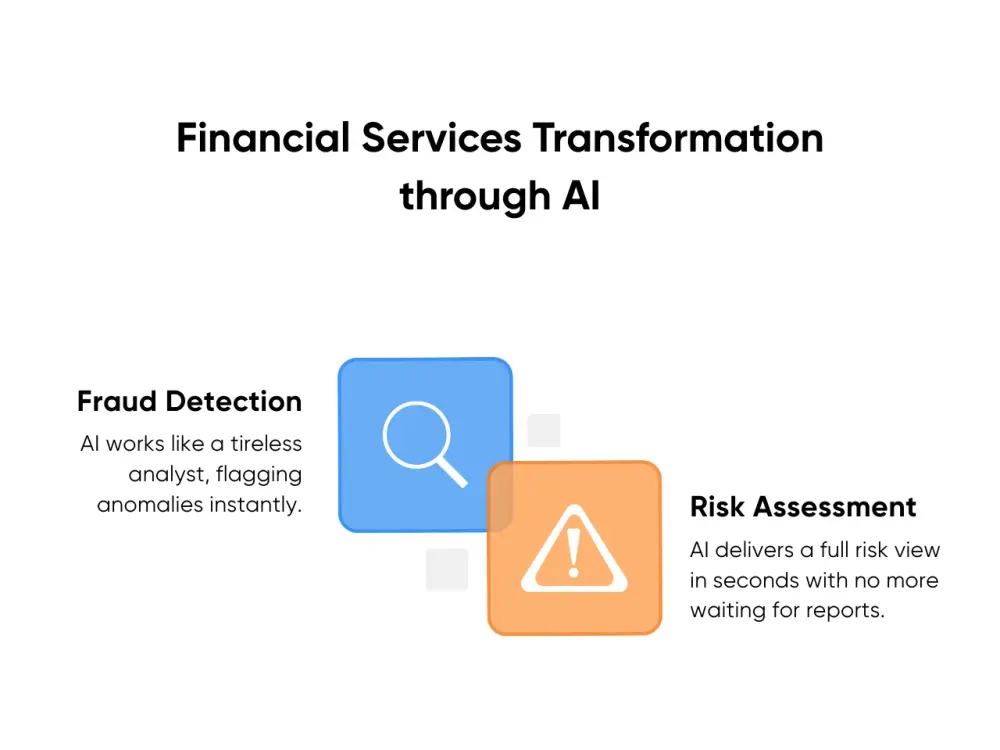
In financial services, even the smallest oversight can turn into an expensive mess. Like, a missed fraud detection alert, a delayed risk management decision, or a market shift you didn’t see coming. Most organizations already have controls in place, but those controls are only as good as your ability to act in time. AI for large enterprises solves that by scanning every transaction, every market signal, and every incoming data feed in real time.
Fraud Detection
AI models can be trained to spot fraud patterns faster than a manual review. They scan each transaction in real time and stop suspicious activity on the spot, like when:
- A corporate card processes 15 transactions in three minutes across different cities. The AI freezes it before the next swipe.
- A high-value wire transfer request comes from an employee account logging in from a flagged IP address. It’s paused until the request is verified.
A review team might notice unusual activity later, but manual checks are slower and more prone to error. An AI model scans thousands of transactions across dozens of accounts at once and freezes a flagged transfer before funds leave the account, not days later in an audit report.
Risk Assessment
Risk assessment is an important part of enterprise planning which usually relies on reports that come in weekly or monthly. By then, the best time to act has passed. AI changes that by processing thousands of data points at once (credit history, transaction patterns, market signals) and giving you an immediate score or recommendation. That means you can:
- Approve or decline a loan application while the applicant is still on the call, instead of waiting days for underwriting.
- Rebalance an investment portfolio within hours of a market swing, instead of watching losses mount over the week.
At Aloa, we build AI models for fraud detection and risk scoring that plug directly into your payment processors, trading platforms, or lending systems. That means when the AI spots a threat or opportunity, the system can automatically trigger holds, approvals, or reallocations, without bottlenecks or delays.
It’s the same proactive decision-making process enterprises use to protect billions in assets, adapted so a mid-sized operation can move with the same speed and confidence.
4. AI for Predictive Maintenance in Manufacturing

In manufacturing, equipment downtime can be highly impactful. This is why predictive maintenance is a priority for enterprises. You need machine learning models that monitor equipment in real time and try to predict as many errors as possible, rather than informing you after the fact. Here are some ways in which AI can help:
Sensor Data Analysis
AI-powered monitoring can process thousands of data points from vibration, heat, and pressure sensors every second. It flags even the smallest changes that point to bigger problems. For example:
- A press brake’s vibration pattern shifts over two days, so the system recommends an inspection before a full stoppage hits mid-production.
- Heat sensors on a conveyor motor show an upward trend, then maintenance swaps the part before the bearings seize.
By catching those signals early, you decide when to pull a machine offline instead of being forced into a shutdown. That keeps production on schedule, gives your team time to plan the repair, and avoids the higher costs that come with emergency fixes.
Maintenance Scheduling Optimization
Predictive models can also help you plan maintenance in a way that reduces costs and downtime. That might mean:
- Combining several minor repairs into a single service window and cut downtime by nearly half.
- Delaying non-critical work until after a priority production run, without risking failure.
When we design predictive maintenance systems at Aloa, we connect them directly to manufacturing execution systems (MES) and ERP platforms. So, when the AI spots a potential failure, it can automatically book the repair into your production schedule.
That’s how large enterprises can protect throughput without over-servicing equipment. And how you can run with the same operational efficiency without carrying the same overhead.
5. Enhancing Marketing Strategies with AI
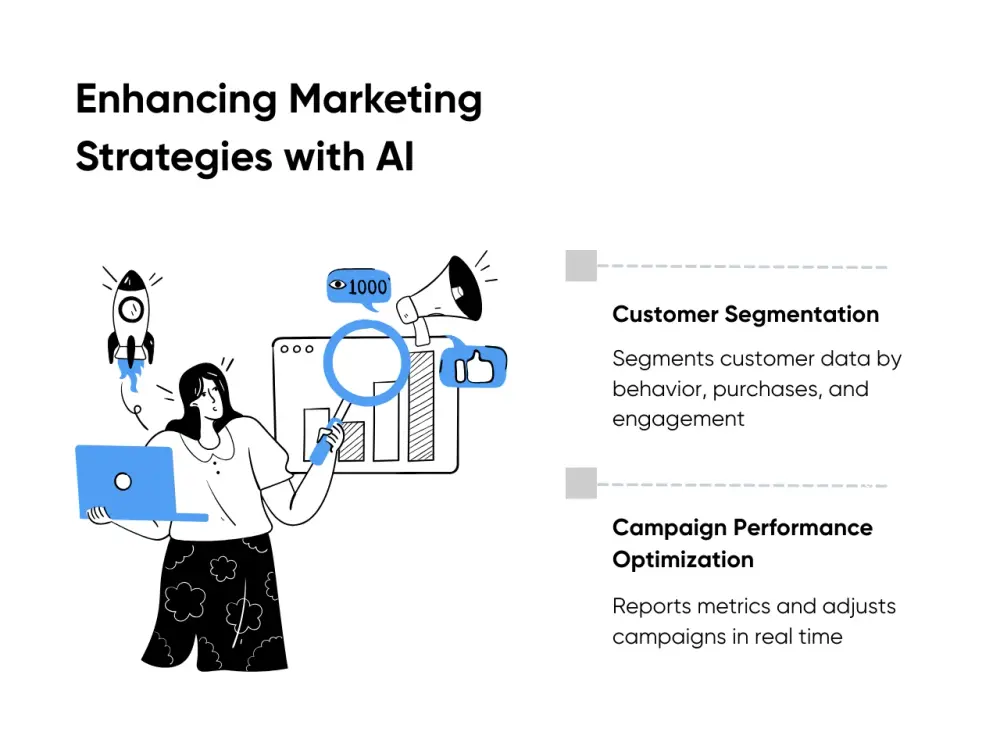
At scale, marketing is less about clever taglines and more about precision. Large enterprises use AI technology to analyze millions of interactions and decide, in real time, where to spend the next marketing dollar. That’s how they stretch budgets further and keep campaigns relevant. Now you can achieve most of your marketing goals without the same marketing spend.
Customer Segmentation
You can use AI to break down your customer data into actionable groups based on behavior, purchase history, and engagement patterns. For example, you can:
- Identify customers who always respond to email offers within 48 hours, and time campaigns to hit that exact window.
- Flag late-night browsers of high-margin products, then trigger ads during their most active hours.
Campaign Performance Optimization
Campaign performance optimization means improving a campaign while it’s still running. For ads, that might mean shifting budget to the channels and messages getting the most clicks. For email, it could be testing subject lines on the first batch and then sending the rest with the one that works best. With AI, those adjustments happen as the data comes in, such as:
- Ad Campaigns: Shift spend to a channel delivering 25% higher engagement, or replace an ad mid-campaign when another version performs better.
- Email Campaigns: Test two subject lines on the first 5,000 sends, then send the next 50,000 with the one pulling higher open rates.
When campaigns adjust like this, ad dollars go to what’s working, and emails get more clicks without extra effort. The result is stronger returns from the same budget. At Aloa, we build AI marketing tools that connect to your CRM so these changes run automatically, giving your team enterprise-level efficiency without adding more work.
6. AI-Driven Innovation in Product Development

Bringing a new product to market is always a balancing act. Moving too slowly risks missing market shifts, while moving too fast risks overlooking the due diligence needed to discover what customers actually want.
This is why large enterprises use AI capabilities to assist with their go-to-market strategy. And this could apply to mid-sized businesses as well.
Idea Validation
Before you commit resources to a new product or feature, you need evidence it will matter to your customers. AI can scan reviews, support tickets, and industry forums to surface patterns you might overlook. For example:
- Negative reviews for a competitor’s product highlight where users are frustrated, and where you can design something better.
- A rise in conversations on industry forums or social media signals growing interest in a feature before it goes mainstream.
Instead of guessing or relying only on gut instinct, you canprioritize product features with the highest chance of adoption. That means fewer wasted launches and a better chance your next release hits the mark.
Rapid Prototyping Support
Generative AI and machine learning can create, test, and refine designs much more rapidly than humans. For enterprises, this could mean:
- Generate dozens of variations for a component and run digital stress tests to narrow the field to the most promising designs.
- Simulate how different materials affect weight, durability, and production costs so you can make informed sourcing decisions early.
At Aloa, we don’t just bolt AI onto your workflow. We bake it in from the start. That might mean linking a feedback-mining model directly to your customer service logs or connecting a computer vision testing engine straight to your CAD system. The result is faster development, lower operational costs, and products shaped by real-world demand, not internal guesswork.
7. Strategic AI Integration for Operational Efficiency
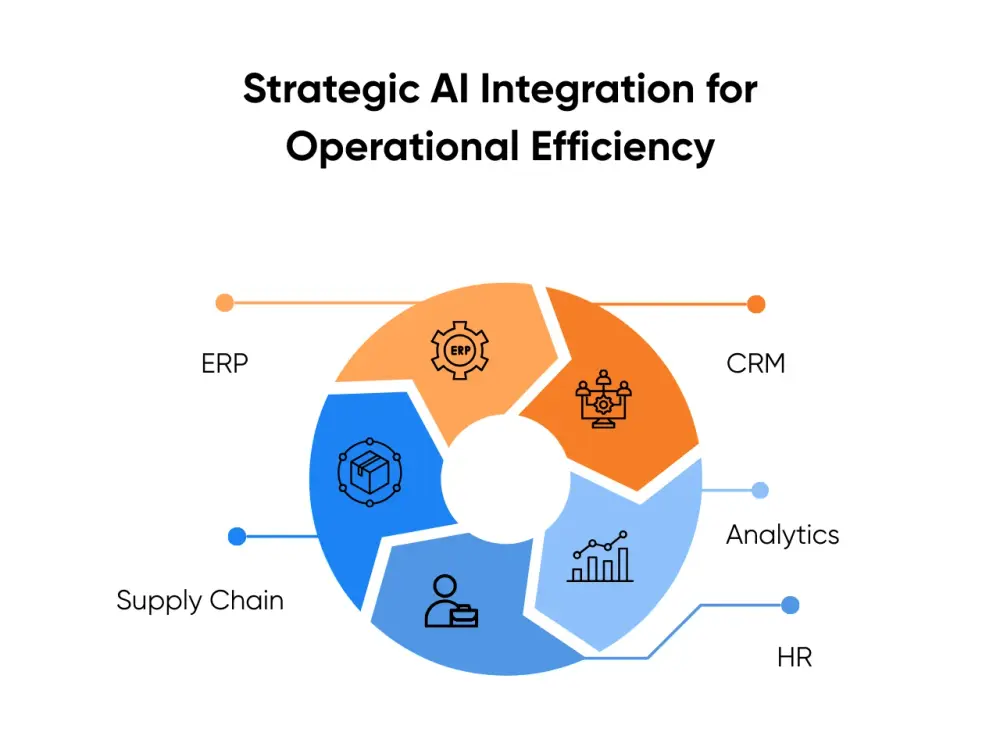
For enterprises, AI adoption rarely fails because the technology can’t perform. It fails when AI tools sit in silos, disconnected from the systems and people making daily decisions. Here’s how you can tackle these challenges:
Process Automation
When repetitive, rule-based tasks consume too much time, process automation can hand them off to AI. That frees your people to focus on work that drives growth. For example:
- AI can read PDFs, match them to purchase orders, and flag mismatches before payments go out, which reduces the risk of overpaying vendors.
- Instead of staff pulling numbers from different systems, AI compiles weekly reports, formats them, and routes them to the right business units automatically.
- New-hire paperwork, system access setup, and policy acknowledgments can run in the background so managers spend time mentoring instead of chasing forms.
The benefit isn’t just fewer hours lost to busywork. It’s fewer payment errors, faster reporting cycles, and smoother day-to-day operations across departments.
Cross-System Data Syncing
Slow, disconnected systems make it impossible to make better decisions quickly. AI acts as a translator, keeping information aligned across tools by:
- Updating customer data from your CRM to your billing platform in near real time, so account managers always see the latest information.
- Pulling inventory counts from multiple warehouses into one dashboard that refreshes every hour, which reduces mistakes in resource allocation.
When we implement AI for operational efficiency at Aloa, it’s never about adding “just another tool.” We make sure it integrates with your ERP, CRM, analytics stack, and data governance workflows so the right information flows instantly to the people who need it. That’s how you turn AI from a pilot program into a daily operational advantage, and keep it delivering long after the novelty wears off.
Key Takeaways
The real power of AI for large enterprises (and for you) lies in how it gets integrated into complex operations. The strategies we covered work because they’re tied to measurable outcomes: lower costs, faster turnarounds, better use of resources.
I’ve also watched mid-sized companies start small, integrate deeply, and build on their successes. You don’t need a 50-person data science team to tap into AI’s potential in an enterprise company. You just need the right tools, connected to the right systems, solving the right problems.
If you want to explore how to make that happen, take a look at Aloa’s AI development services. We design AI tailored to your size and goals. Schedule a call today and take the first step toward lower costs, faster turnarounds, and better use of resources.